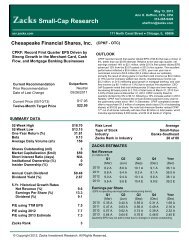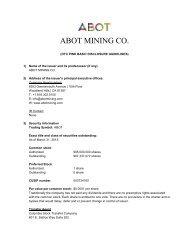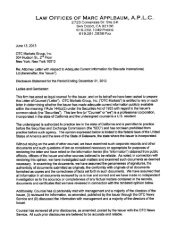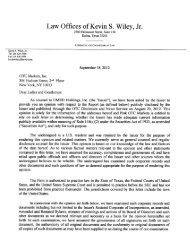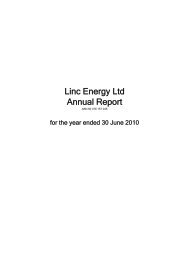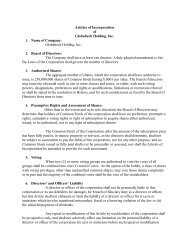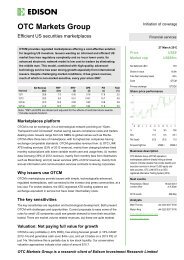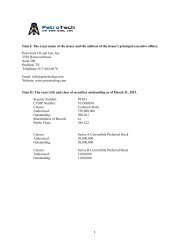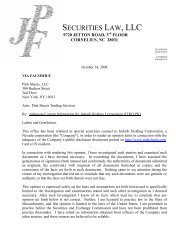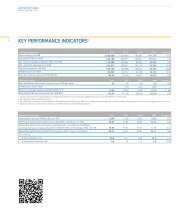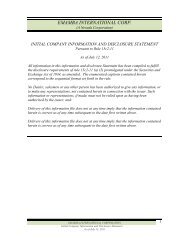2011 Annual Report - OTCIQ.com
2011 Annual Report - OTCIQ.com
2011 Annual Report - OTCIQ.com
Create successful ePaper yourself
Turn your PDF publications into a flip-book with our unique Google optimized e-Paper software.
and joint operations. The provisions of IFRS 10 form the basis<br />
for determining joint control. If after assessing the particular<br />
facts a joint venture is determined to exist, it must be<br />
accounted for using the equity method. In the case of a joint<br />
operation, however, the attributable shares of assets and liabilities,<br />
and of expenses and in<strong>com</strong>e, must be assigned directly<br />
to the equity holder. The application of the new standard will<br />
be mandatory for fiscal years beginning on or after January 1,<br />
2013. Earlier application is permitted as long as the standards<br />
IFRS 10, IFRS 12, IAS 27 and IAS 28 are also being applied at the<br />
same time. The standard has not yet been transferred by the<br />
EU into European law. E.ON is currently evaluating the impact<br />
on its Consolidated Financial Statements.<br />
IFRS 12, “Disclosure of Interests in Other Entities”<br />
IFRS 12 regulates the disclosure requirements for both IFRS 10<br />
and IFRS 11, and was published by the IASB together with<br />
these standards on May 12, <strong>2011</strong>. The standard requires entities<br />
to publish information on the nature of their holdings, the<br />
associated risks and the effects on their net assets, financial<br />
position and results of operations. This information is required<br />
for subsidiaries, joint arrangements, associates and unconsolidated<br />
structured units (special-purpose entities). Important<br />
discretionary decisions and assumptions, including any changes<br />
to them, that were made in determining control according<br />
to IFRS 10 and for joint arrangements must also be disclosed.<br />
The application of the new standard will be mandatory for<br />
fiscal years beginning on or after January 1, 2013, with earlier<br />
application permitted. The standard has not yet been transferred<br />
by the EU into European law. E.ON is currently evaluating<br />
the impact on its Consolidated Financial Statements.<br />
IFRS 13, “Fair Value Measurement”<br />
In May <strong>2011</strong>, the IASB issued the new standard IFRS 13, “Fair<br />
Value Measurement” (“IFRS 13”). The objective of the standard<br />
is to define the term “fair value” and to establish guidance<br />
and disclosure requirements for fair value measurement that<br />
should be applied across standards. In the standard, fair<br />
value is defined as the price that would be received to sell an<br />
asset or paid to transfer a liability in an orderly transaction<br />
between independent market participants at the measurement<br />
CEO Letter<br />
E.ON Stock<br />
Combined Group Management <strong>Report</strong><br />
Consolidated Financial Statements<br />
Corporate Governance <strong>Report</strong><br />
Supervisory Board and Board of Management<br />
Tables and Explanations<br />
date. For non-financial assets, the fair value is determined<br />
based on the highest and best use of the asset as determined<br />
by a market participant. IFRS 13 takes effect on January 1, 2013,<br />
and is applied prospectively, with earlier application permitted.<br />
The standard has not yet been transferred by the EU into<br />
European law. E.ON is currently still evaluating the impact on<br />
its Consolidated Financial Statements.<br />
IAS 27, “Separate Financial Statements”<br />
In May <strong>2011</strong>, the IASB issued a new version of IAS 27. The new<br />
version now contains regulations for IFRS separate financial<br />
statements only (previously consolidated and separate financial<br />
statements). The application of the new standard is to be<br />
mandatory for fiscal years beginning on or after January 1, 2013.<br />
Earlier application is permitted as long as the standards IFRS 10,<br />
IFRS 11, IFRS 12 and IAS 28 are also being applied at the<br />
same time. The standard has not yet been transferred by the<br />
EU into European law. E.ON anticipates no effects from the<br />
new standard.<br />
IAS 28, “Investments in Associates and Joint Ventures”<br />
In May <strong>2011</strong>, the IASB issued a new version of IAS 28. The new<br />
version now stipulates that in planned partial disposals of<br />
interests in associates and joint ventures, the portion to be sold<br />
must, if it meets the criteria of IFRS 5, “Non-Current Assets<br />
Held For Sale and Discontinued Operations” (“IFRS 5”), be classified<br />
as a non-current asset held for sale. The remaining investment<br />
shall continue to be accounted for using the equity<br />
method. If the sale results in the creation of an associate, that<br />
associate will be accounted for using the equity method.<br />
Otherwise, the rules of IFRS 9 must be followed. The new IAS 28<br />
incorporates the provisions of SIC-13 and removes currently<br />
existing exceptions from the scope of IAS 28. The new version<br />
is to be mandatory for fiscal years beginning on or after<br />
January 1, 2013. Earlier application is permitted as long as the<br />
standards IFRS 10, IFRS 11, IFRS 12 and IAS 27 are also being<br />
applied at the same time. The standard has not yet been transferred<br />
by the EU into European law. E.ON is currently evaluating<br />
the effects of the new standard.<br />
91



